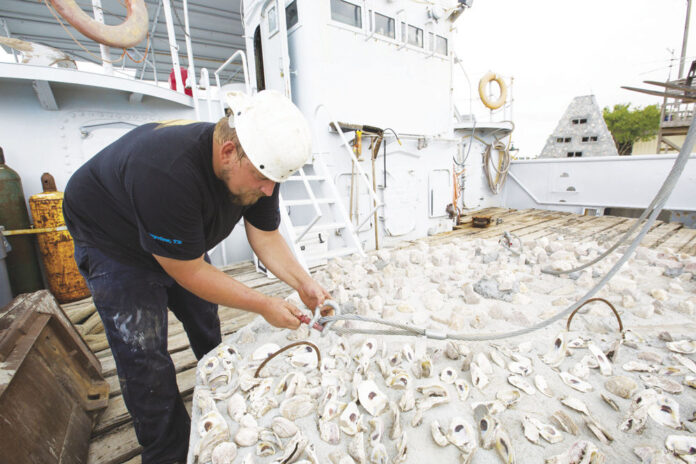BY RAUL GARCIA
Staff Writer
and Steven Masso
SOUTH PADRE ISLAND — Lil’ Mo recently hauled 667 tons of cinder block out into the Gulf.
The Vietnam-era landing craft has been on a mission to create the largest industrial nursery reef to boost the local red snapper population.
But Lil’ Mo might not be sticking around for the last load of 3,000 tons of cinder block needed for the reef.
The last batch of material may not be deployed from the Port of Brownsville unless organizers can obtain a crane to move to the last loads of block from the docks to the boat.
Now, Friends of RGV Reef would like some help with funds to acquire a crane so they can finishing building the reef.
Friends of RGV Reef, a nonprofit organization dedicated to preserving marine life, has been key in helping fund the reef operations.
Donations from across the United States have helped with the costs of building the artificial reef.
“There is nobody on the coast doing what we’re doing,” said Gary Glick, Friends of RGV Reef president.
“We’re going to save more fish that otherwise would die.”
Friends of RGV Reef have already dropped 63,000 cinder blocks equaling 667 tons to begin to boost the red snapper population near the Island.
The University of Texas Rio Grande Valley dropped 50, 8-foot-tall reef pyramids and 10 study reef modules to study the red snapper.
The reef is in state waters 14 nautical miles north of the Brazos Santiago Pass jetties. It is a total of 1,650 acres, equaling 2.5 square miles.
Most reefs are 80 acres. Glick said the reason this reef was made so large is to generate the first truly industrial scale habitat for reef fish.
“What we figured out is there is a tremendous number of juvenile snapper that just never make it because there is not enough rock to hide behind,” Glick said.
He said in Texas you don’t see a lot of little fish because the big fish eat them and red snapper are good to eat.
“Fish are dying to find something to get out of the current and to out turn the predator fish,” Glick said. “It also gives them a place to ambush their prey.”
Most fishermen will say it’s hard to catch a red snapper.
“The dream of RGV Reef is to crate a growing habitat for red snapper for an average parent to take their child fishing to catch red snapper.”
In the long run, Friends of RGV Reef believe the reef will create 50 million to $60 million in economic impact to the fishing industry.
Researchers from UTRGV’s School of Earth, Environmental, and Marine Sciences in the College of Sciences, in collaboration with Texas A&M Corpus Christi and Texas A&M Galveston, are involved in building one of the biggest artificial “low-profile” reefs in the Gulf of Mexico.
Commonly known as the “RGV Reef,” the reef-building structures are made up of limestone rubble, oyster shells and concrete. The reef itself is located 13.9 nautical miles north of the South Padre Island jetties, and 7.4 nautical miles offshore.
The reef will rest at an average depth of 64 feet.
Studies conducted at UTRGV determined that juvenile fish need a habitat that is smaller, and separate from the larger reefs, in order to have a safe environment from predators.
“We’re hoping to increase the number of red snapper and aid the fisheries in general,” said Catheline Froehlich, who holds a master of science in biology from UTRGV legacy institution UTB/TSC. “They have a lot of pressure right now from overfishing.”
Maintaining the red snapper population in the Gulf of Mexico is not only crucial to the area’s environmental balance, area leaders say, but also to the local economy: Red snapper is the area’s fourth most commercial fish, and maintaining a healthy, balanced marine environment is key.
“Within a few months, we’ve already seen a good amount of juvenile fish in the area,” Froehlich said. “It’s almost an immediate effect of having a productive reef.”
Froehlich said the reef project is part of a greater effort to enhance and rebuild marine life through the addition of artificial reefs.
Ongoing efforts over the past decade include the sinking of the 473-foot Texas Clipper in 2007, as well as the sinking of two ships in November 2016.
The research behind the operation has been funded by the Texas Parks and Wildlife Artificial Reef Program and the OneGulf Grant. OneGulf is a team made up of nine institutions united to promote collaborative research and operations dedicated to restoring and protecting the environment and economy of the Gulf Coast region.
What is a reef?
Natural reefs are made of coral or rock.
Artificial reefs may be made of concrete, ship wrecks and any other man-made structure.
Warm waters are required for the skeletons of corals to grow. Most reefs are composed of live coral living on a foundation of dead coral.
The Great Barrier Reef, in Australia, is the longest continuous series of reefs in the world and is made up of more than 1,500 individual reefs that rest on a continental shelf.
To help with the reef project, go to the Friends of RGV Reef website.
Over Fourth of July weekend the Friends of RGV Reef made an artificial nursery reef for red snapper:
63,000 cinder blocks
667 tons of blocks
50, 8-foot pyramids reefs
10 study reefing modules
Has sunk two boats
Project will boost the local red snapper population
The Rio Grande Valley Reef project
Will cover 1,650 acres of Texas waters
14 nautical miles north of Island jetties
Eight miles off shore




